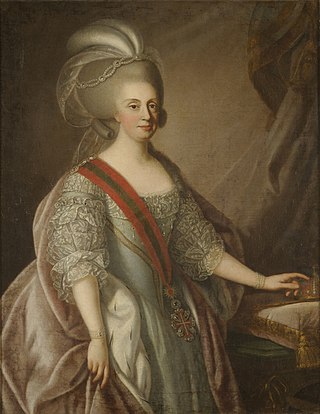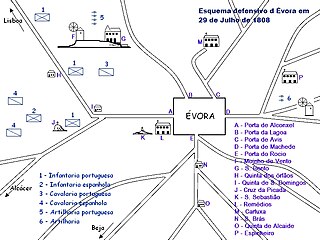
The Peninsular War (1807–1814) was the military conflict fought in the Iberian Peninsula by Spain, Portugal, and the United Kingdom against the invading and occupying forces of the First French Empire during the Napoleonic Wars. In Spain, it is considered to overlap with the Spanish War of Independence.

Dona Maria I was Queen of Portugal from 24 February 1777 until her death in 1816. Known as Maria the Pious in Portugal and Maria the Mad in Brazil, she was the first undisputed queen regnant of Portugal and the first monarch of Brazil.

Portugal is a unitary state with delegated authority to three levels of local government that cover the entire country:

Feijoada is a stew of beans with beef and pork. The name feijoada is derived from feijão, 'bean' in Portuguese. Varieties are prepared in the Portuguese-speaking world. The basic ingredients of feijoada are beans and fresh pork or beef. Beef is usual in halal and kosher varieties, which never include pork for religious reasons.

The Kingdom of Etruria was an Italian kingdom between 1801 and 1807 that made up a large part of modern Tuscany. It took its name from Etruria, the old Roman name for the land of the Etruscans.

The Kingdom of Northern Lusitania was a kingdom proposed by Napoleon in 1807 for the king of Etruria, Charles Louis, located in the North of Portugal.

The history of the kingdom of Portugal and the Algarves, from the First Treaty of San Ildefonso and the beginning of the reign of Queen Maria I in 1777, to the end of the Liberal Wars in 1834, spans a complex historical period in which several important political and military events led to the end of the absolutist regime and to the installation of a constitutional monarchy in the country.

Pedro de Alcántara Álvarez de Toledo y Salm-Salm, 13th Duke of the Infantado (1768–1841) was a Spanish military commander and politician.
The Portuguese postal code is formed by four digits, a hyphen, then three digits, followed by a postal location of up to 25 characters in capitals.
Avenida Marconi 4C 1000-205 Lisboa

The term "provinces" has been used throughout history to identify regions of continental Portugal. Current legal subdivisions of Portugal do not coincide with the provinces, but several provinces, in their 19th- and 20th-century versions, still correspond to culturally relevant, strongly self-identifying categories. They include:

The evacuation of La Romana's division in August 1808 was a military operation in which a division of troops belonging to the Kingdom of Spain and commanded by Pedro Caro, Marquis of La Romana defected from the armies of the First French Empire. The Spanish troops were part of the Imperial forces in Denmark, which were under the leadership of Marshal Jean-Baptiste Bernadotte. Most of the Spanish troops were successfully evacuated by the British navy and shipped to Santander, Spain to fight against France in the Peninsular War.

The Battle of Évora saw an Imperial French division under Louis Henri Loison attack a combined Portuguese-Spanish force led by Francisco de Paula Leite de Sousa. Encountering Leite's smaller body of soldiers outside Évora, the French easily brushed them aside and went on to storm the city, which was held by poorly armed townsmen and militia. The French butchered the Portuguese defenders and brutally sacked the town.

The invasion of Portugal saw an Imperial French corps under Jean-Andoche Junot and Spanish military troops invade the Kingdom of Portugal, which was headed by its Prince Regent João of Bragança. The military operation resulted in the occupation of Portugal. The French and Spanish presence was challenged by the Portuguese people and by the United Kingdom in 1808. The invasion marked the start of the Peninsular War, part of the Napoleonic Wars.
The following tables show the sequence of events of the Peninsular War (1807–1814), including major battles, smaller actions, uprisings, sieges and other related events that took place during that period.

The Spanish Army of the Peninsular War refers to the Spanish military units that fought against France's Grande Armée during a period which coincided with what is also termed the Spanish War of Independence.

Manuel de Godoy y Álvarez de Faria Rios, 1st Prince of the Peace, 1st Duke of Alcudia, 1st Duke of Sueca, 1st Baron of Mascalbó, was the First Secretary of State of the Kingdom of Spain from 1792 to 1797 and then from 1801 to 1808, and as such, one of the central Spanish political figures during the rise of Napoleon and his invasion of Spain. Godoy came to power at a young age as the favourite of King Charles IV and Queen Maria Luisa. He has been partly blamed for the Anglo-Spanish War of 1796–1808 that brought an end to the Spanish Empire. Godoy's unmatched power ended in 1808 with the Tumult of Aranjuez, which forced him into a long exile, dying in Paris in 1851.
Francisco Taranco y Llano was a Spanish military officer and Captain-General of Galicia.














